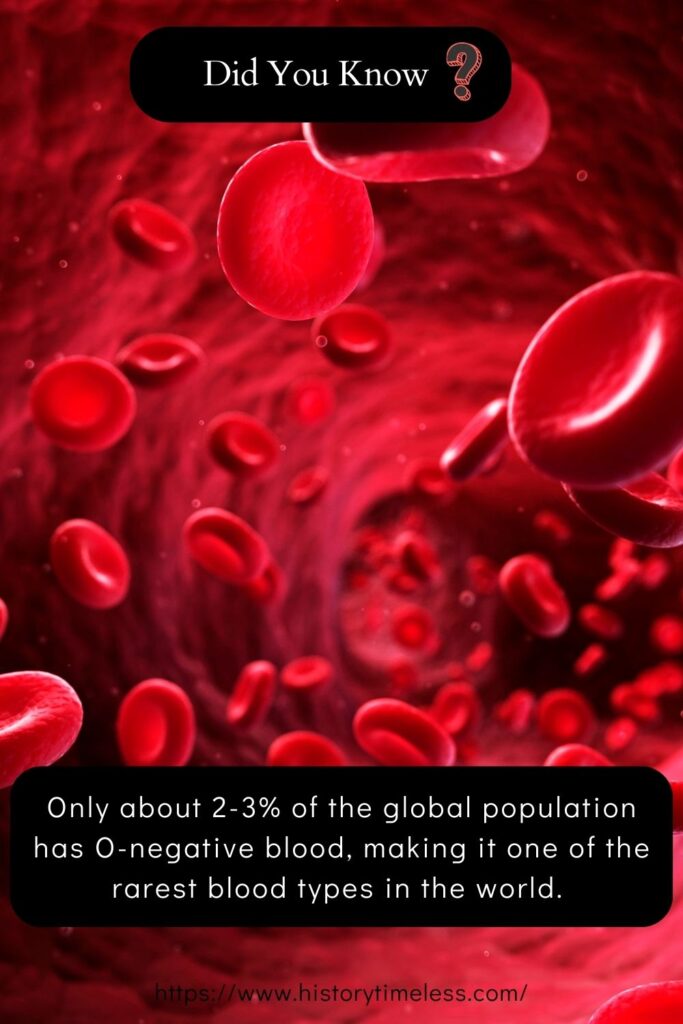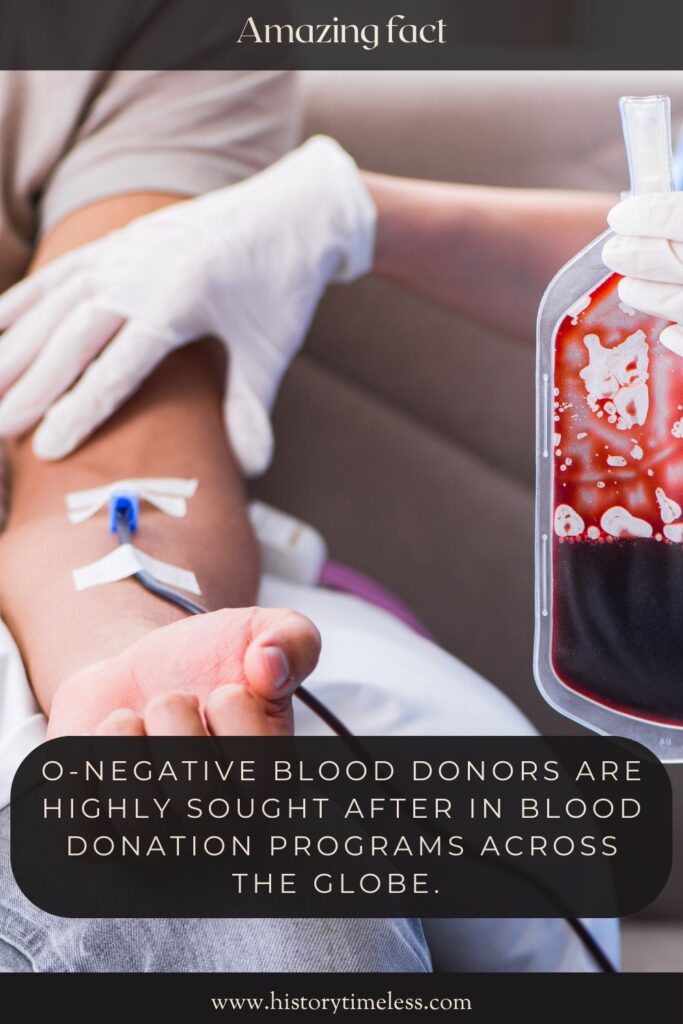O-negative blood type is considered one of the most unique and essential blood types, known for its universal donation properties.
People with O-negative blood can donate to anyone, making it incredibly valuable in emergencies and medical procedures. However, it’s quite rare, with only about 2-3% of the world’s population possessing it.
The characteristics of O-negative blood go beyond just its donation abilities, with specific traits that make it stand out in both medical and genetic contexts. Below, we explore 25 interesting and lesser-known facts about this rare and vital blood type.
1. O-Negative Blood Is the Universal Donor
O-negative blood is the universal blood donor for all blood types. This means that individuals with O-negative blood can donate to anyone, regardless of the recipient’s blood type.
This property is extremely valuable in emergency situations where matching blood types may not be readily available.
Hospitals often keep a supply of O-negative blood for this reason. However, while it can be donated to anyone, O-negative recipients can only receive O-negative blood, making it somewhat limited for transfusions.
2. It’s Rare and Hard to Find
Only about 2-3% of the global population has O-negative blood, making it one of the rarest blood types in the world.

Its rarity is not only a challenge for matching donors with recipients, but it also means that people with O-negative blood have a special responsibility to donate whenever possible.
In many cases, O-negative donors are in high demand, and blood drives focus on encouraging these individuals to contribute regularly to help maintain the supply.
3. O-Negative Blood Can Save Lives in Emergencies
In emergency situations like car accidents, natural disasters, or surgeries, blood type compatibility may not be immediately available. O-negative blood is often used because it can be transfused into any patient without the need for an immediate match.
This makes it crucial in life-threatening emergencies when time is of the essence and a fast blood transfusion is required to save a person’s life.
4. O-Negative Blood Has Unique Genetic Traits
People with O-negative blood tend to have specific genetic markers that differentiate them from those with other blood types.
These genetic markers have been studied in relation to various medical conditions and traits. For example, individuals with O-negative blood have been found to have a lower risk of certain types of cancer and blood clotting disorders. This is just one of the many ways genetics can influence health outcomes based on blood type.
5. O-Negative Blood Group and Pregnancy
During pregnancy, a woman with O-negative blood may face challenges if her baby inherits a positive Rh factor from the father.
This could cause Rh incompatibility, leading to a condition called hemolytic disease of the newborn (HDN).
To prevent this, O-negative mothers often receive an injection of Rh immunoglobulin during and after pregnancy to protect against complications. This treatment has made it possible for many women with O-negative blood to have healthy pregnancies.
6. O-Negative Blood and the Rh Factor
The “negative” in O-negative blood refers to the absence of the Rh factor, a protein found on red blood cells. If someone has the Rh factor, their blood type is considered Rh-positive (e.g., O-positive).
The lack of the Rh factor in O-negative blood means that individuals with this type are more likely to experience issues during pregnancy if their baby has Rh-positive blood. This is why O-negative individuals must be more vigilant in managing their blood type compatibility with others.
7. O-Negative Blood Type May Have Ancient Origins
Some researchers believe that the O-negative blood type is one of the oldest blood types, possibly dating back to early human evolution.
Evidence suggests that O-negative blood may have originated during the hunter-gatherer period, as people with this blood type were thought to have had survival advantages.
This theory is still debated, but the idea that O-negative blood has ancient roots adds an interesting layer to its rarity and significance.
8. O-Negative Blood Plays a Key Role in Research
Due to its universal donor properties, O-negative blood is often used in medical research and clinical trials. Scientists and doctors rely on the ability to use O-negative blood for a wide range of studies, including testing new blood treatments, creating artificial blood, and studying blood disorders.
Its ability to safely be used in various populations makes it an invaluable resource for advancing medical science and improving healthcare.
9. O-Negative Blood and Its Impact on Transfusion Medicine
O-negative blood has revolutionized transfusion medicine. In the past, blood type matching was much more complicated, and the chances of a transfusion reaction were higher.
With O-negative blood being universally accepted, patients in need of emergency transfusions are able to receive life-saving blood more easily. This has led to significant advances in trauma care and surgical procedures where blood loss is a concern.
10. O-Negative Blood Is Important for Donor Pools
Because O-negative blood is in such high demand but low supply, blood donation programs emphasize the importance of O-negative donors.
Regular donations are crucial in keeping up with the demand. Blood donation centers actively encourage those with O-negative blood to donate as often as possible, and these donations help ensure that hospitals always have a supply available for patients in need of transfusions.
11. O-Negative Blood Is Essential for Neonatal Transfusions
O-negative blood plays a crucial role in neonatal care, especially for newborns who require blood transfusions. Since infants’ blood types are often not immediately known or matched, O-negative blood is often used for these vulnerable patients.
Its universal donor status ensures that the infant can safely receive the blood without the risk of a transfusion reaction, which is critical in the early stages of life.
12. O-Negative Blood Type and its Link to Disease Resistance
Some studies suggest that people with O-negative blood may have a higher resistance to certain diseases and infections.
Research indicates that individuals with this blood type may have a lower susceptibility to malaria and other vector-borne diseases.
These natural defenses could be the result of the evolution of the O-negative blood type in response to historical environmental pressures, offering a unique advantage in specific regions of the world.
13. O-Negative Blood Donors Are Highly Valued Worldwide
O-negative blood donors are highly sought after in blood donation programs across the globe. Because of its ability to be transfused to any patient, donors with this rare blood type are a vital resource in both routine and emergency situations.

Many blood centers provide special recognition or incentives to O-negative blood donors to encourage regular contributions and maintain an adequate supply.
14. O-Negative Blood Type Has Global Cultural Significance
In various cultures, blood types are thought to have a deep connection with personality traits and behavior. While these beliefs are not scientifically supported, O-negative blood type is sometimes associated with individuals who are considered more empathetic or selfless.
In Japan and other countries, blood type is even used as a social classification system, influencing how people perceive others in social and professional settings.
15. O-Negative Blood and the Rise of Blood Substitutes
The rarity of O-negative blood has driven research into developing blood substitutes. Scientists have been exploring artificial blood products that could mimic the function of natural human blood.
While these substitutes are still in the experimental stages, they hold promise for providing a stable supply of blood in situations where O-negative donations may be scarce or unavailable.
16. O-Negative Blood Type and Its Role in Organ Donation
In addition to its importance in blood transfusions, O-negative blood type also plays a critical role in organ donation. O-negative blood recipients are often in high demand for organ transplants, as their bodies can receive organs from any donor blood type.
This universal compatibility helps maximize the chances of a successful organ transplant and improve overall survival rates for transplant patients.
17. O-Negative Blood and Its Rare Compatibility with Other Rh-Negative Types
While O-negative blood can be donated to any Rh-positive recipient, it can only receive blood from other O-negative or Rh-negative blood types. This creates a unique compatibility dynamic where individuals with O-negative blood must rely on a smaller pool of potential donors, making it vital for them to donate regularly to ensure availability for others in need.
18. O-Negative Blood Type May Be More Common in Certain Regions
Although O-negative blood is globally rare, it appears to be more prevalent in certain regions, particularly in areas of Europe. For example, it is more common in countries like Spain and Iceland, where a higher percentage of the population carries this rare blood type.
This regional variation highlights the genetic diversity and evolutionary factors influencing the distribution of blood types.
19. O-Negative Blood Can Support Medical Advancements in Transfusion Therapy
Due to its universal compatibility, O-negative blood is often used in clinical studies that explore new transfusion therapies, including testing blood substitutes and blood preservation methods.
By using O-negative blood in these trials, researchers can ensure the results apply to the broadest possible population, which helps improve the safety and efficacy of new blood-related treatments.
20. O-Negative Blood Type Has Unique Compatibility with Blood Plasma
O-negative blood not only plays a crucial role in red blood cell transfusions but also holds significance in blood plasma donations.
People with O-negative blood are often ideal plasma donors because their plasma can be used to treat patients with various medical conditions, including burn victims and those undergoing surgeries.
O-negative plasma donations help save lives by providing patients with essential proteins and clotting factors.
21. O-Negative Blood May Help with Genetic Studies
O-negative blood is often used in genetic studies and medical research due to its rare genetic markers. By studying the blood type’s genetic makeup, scientists can gain insights into human evolution and the distribution of different blood types around the world.
The unique properties of O-negative blood can offer clues about ancient human populations and the ways they adapted to their environments over time.
22. O-Negative Blood Is a Lifesaver in Trauma Situations
In severe trauma cases, such as those caused by accidents or violence, patients often lose large amounts of blood. O-negative blood is crucial in these situations because it can be transfused quickly, regardless of the patient’s blood type.
This is especially important when doctors and medical staff need to act fast, as O-negative blood is universally compatible and helps stabilize the patient without waiting for specific matching blood.
23. O-Negative Blood Has an Important Role in Pediatric Care
O-negative blood is critical for treating children in need of blood transfusions, especially in neonatal and pediatric care units.
Since it can be given to young patients without the risk of an adverse reaction, it is often used for infants undergoing surgery or those with severe anemia.
Its safety and versatility make it a go-to choice for pediatricians dealing with young patients in emergency settings.
24. O-Negative Blood Type Can Be Found in Ancient Bloodlines
Some historical theories suggest that O-negative blood type may be connected to ancient bloodlines, including the possibility of individuals with O-negative blood being descendants of early human species.
This idea is rooted in the mystery and rarity of the blood type, which has led to various myths and legends about its origins and significance.
While no conclusive evidence proves this, the connection between O-negative blood and ancient human history remains a topic of interest.
25. O-Negative Blood Can Be Donated More Frequently
O-negative blood donors are often encouraged to donate more frequently than those with other blood types, as their blood is in high demand and low supply.
Most blood donation organizations recommend that O-negative donors contribute every 56 days (the standard for most blood types), but this regular donation is critical to maintaining a steady supply.
By donating frequently, O-negative individuals help ensure that this rare and essential blood type is available when needed most.
Take in these wondrous snippets:
26 Amazing Facts About Dog That Will Melt Your Heart!
25 Shocking Rh-Negative Blood Facts You Need to See!
20+ Insane Facts About Animals That Defy Belief!
15+ Interesting World Facts: Say ‘Wow’ to These Discoveries!





